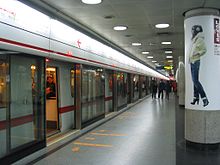Public transport in Shanghai
Shanghai has an extensive public transport system, largely based on buses, trolley buses, taxis, and a rapidly expanding metro system. Shanghai has invested heavily in public transportation before and after the 2010 World Expo, including the construction of the Hongqiao Transportation Hub of high-speed rail, air, metro and bus routes.[1]
All public transport can be paid for using the contactless Shanghai Public Transportation Card.
Shanghai Metro[]


As of July 2020, the Shanghai Metro rapid-transit system and elevated light metro has 18 lines (numbers 1, 2, 3, 4, 5, 6, 7, 8, 9, 10, 11, 12, 13, 15, 16, 17, 18 and Pujiang Line) and extends to every core urban district as well as neighbouring suburban districts except Jinshan and the rural Chongming Districts. Several other lines are under construction. It is the longest metro system in the world with more than 673 km of lines.[2] The first line opened in 1993.[3]
Tram[]
Trams in Shanghai were originally phased out after 1963, and completely closed December 1, 1975 on line 3, but a modern tram line opened in 2010: Zhangjiang Tram. Another tram system known as the Songjiang Tram was first opened in 2018 which currently has two lines (T1 & T2) that serves the Songjiang District.
Bus[]

Shanghai has one of the world's most extensive bus systems with nearly one thousand bus lines, operated by numerous transportation companies. Not all of Shanghai's bus routes are numbered - some have names exclusively in Chinese.[4] Bus fares are usually ¥2, sometimes higher or lower, while Metro fares run from ¥3 to ¥11 depending on distance.
Trolleybus[]
Opened in 1914, Shanghai has the world's oldest continuously operating trolley bus system. As at 2017 there are 13 routes, and all trolleybuses are now air-conditioned.
Taxi[]

Taxi transportation in Shanghai are offered by 6 major taxi groups.
强生出租 (Qiangsheng Taxi) is the biggest taxi company in Shanghai, they operate green and yellow taxis. They also operate a small fleet of accessible golden "London Taxis", making them the only company in Shanghai to operate accessible taxis.
海博出租 (Haibo Taxi) operate blue taxis. They operate a small fleet of Roewe all-electric taxis.
大众出租 (People's Taxi) operate light cyan taxis over Shanghai. They are the official taxi carrier of the 2010 Shanghai EXPO
锦江出租 (Jinjiang Taxi) is a subsidiary of the Shanghai Jinjiang International holdings. They operate white taxis all across Shanghai.
蓝色联盟 (Blue Alliance) is a major taxi group consisting of about 15 smaller taxi companies, they operate under the brand Blue Alliance, but all have their own branding on the back of the for-hire sign. They operate dark blue taxis in central Shanghai.
法兰红 (French Red) is another taxi group consisting of about 10 smaller taxi companies. They function the same as Blue Alliance, and operate orange taxis in central Shanghai.
Taxi fare is regulated by Shanghai Government at rate ¥2.40/km or ¥3.20/km after 23:00. (¥14.00(sedan)/¥18(MPV) for the first 3 km, ¥18.00 after 23:00).
Maglev[]

The Shanghai maglev train, first commercial Maglev railway in the world, was constructed by Transrapid of Germany in cooperation with the Shanghai municipality and the Shanghai Maglev Transportation Development Co (SMT). The route runs from Shanghai's Longyang Road subway station in Pudong to Pudong International Airport. Commercial operation started in 2003. The 30 km trip takes 7 minutes and 21 seconds and reaches a maximum speed of 431 km/h (267.8 mph). Normal operating speeds usually reach 431 km/h, but during a test run, the Maglev has been shown to reach a top speed of 501 km/h[citation needed].
Rail[]
Two railways intersect in Shanghai: Jinghu Railway (Beijing–Shanghai) Railway passing through Nanjing, and Huhang Railway (Shanghai–Hangzhou). Shanghai is served by three main railway stations, Shanghai railway station, Shanghai South railway station and Shanghai Hongqiao railway station. The high-speed railway to Beijing opened in 2011.
References[]
- ^ Knight Frank China Knight Frank China Research, Shanghai Annual Industrial Market Report 2009
- ^ "上海地铁".
- ^ "Shanghai Subway - Metro". UrbanRail.Net. Archived from the original on 2008-05-11. Retrieved 2008-05-15.
- ^ "Personal Cars and China (2003)".[permanent dead link]
External links[]
- Transport in Shanghai
- Public transport in China


